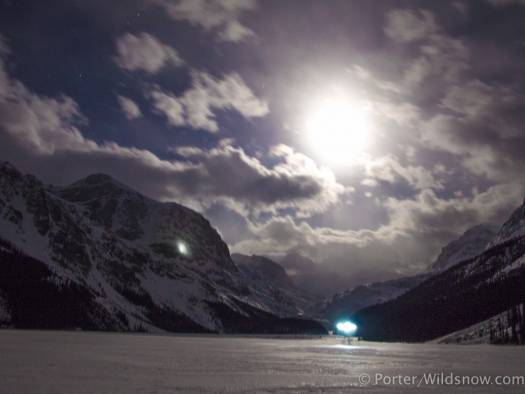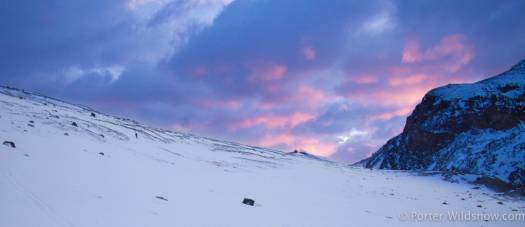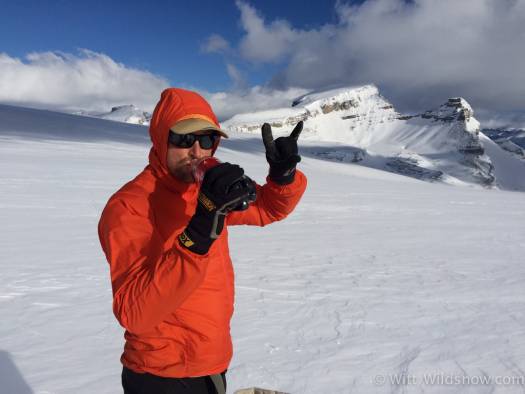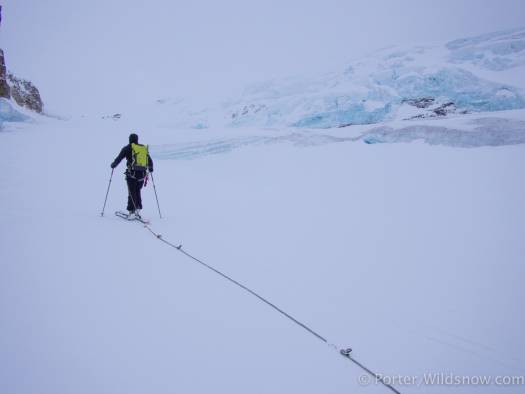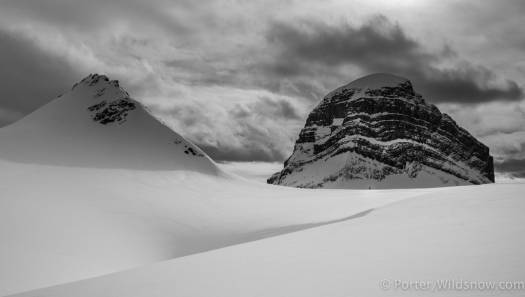Without a doubt, my first exposure to the icefield skiing of Canada’s Mountain Parks was in Lou’s WildSnow article about skiing Snowdome with Lisa. At the time, in the early days of my late 1990’s ski dreams, this exotic piece from one who was clearly a living legend was equally inspirational and mystifying. There I was, slamming around on Ramer Nato bindings (that now reside in the WS museum) in the dense trees of the northeast. Serac fall, glacier coaches and whiteouts might as well have been on a different planet.
Lou’s own dismissive words on the classic Wapta itinerary, in concert with my own sick preference for WildSuffering has left me passing up a few opportunities up in those Alpine Club of Canada huts. That’s not to say I haven’t chased down Canadian Rockies ski dreams. I love that zone. While every skin track fan boy races to Rogers Pass for the steep and deep, I find myself and my near-annual Canadian pilgrimage drawn to the steep and windblown of the range closer to the plains. It’s just that the Wapta wasn’t a high priority.
Enter the weirdest winter of all. 2015 will be remembered. We’re still formulating our memories. But even if things snap back to average right now, we’ll always have the weirdness. California’s ski seasons (and only slightly correlated, my own life there) are desiccating. Washington is high and dry. Mount Baker is closed. Canadian heli guides are perfecting down hill breakable track-setting. People are “skiing” Flatirons, and Boston is in an ice age.
A guide-candidate buddy and I headed north. Much like Lisa and Lou in ’95, we tried to out-race the rain and slop. Unlike them, we did so in early March. They were north bound ski road tripping in June. And we didn’t win the race. Golden BC was brown and gritty. Rogers Pass held rain and isothermal. The Rockies were wind hammered with even thinner than normal coverage. For one day we tried to fit the square peg of a “normal” backcountry skiing agenda into the round hole that characterizes the winter of 2015. And then we got smart. Go for distance. Go high. Go “different”. Anything different oughta be better.
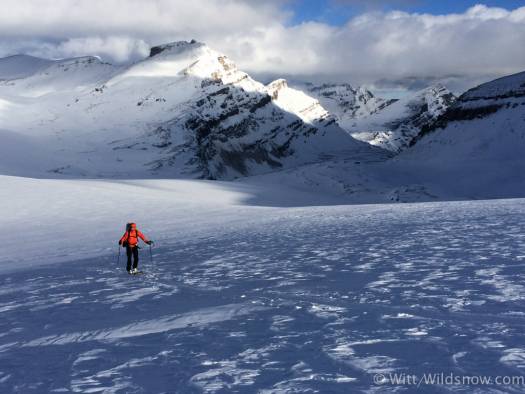
More slogging. The Wapta represents one type of “ski mountaineering”. It is not steep, but it is mountaineering nonetheless.
The need for different, and the “need” for glaciers, and the need for commitment and wilderness brought us to the Wapta. Sure, it’s got huts and crowds. But it also has vistas. And if you do it fast enough, you pass most of the crowded huts before anyone even wakes up. And whose schedule is nimble enough to plan out a classic April traverse for the May conditions of an early March? Jeff and I got lucky with uncrowded wilderness skiing on a mega classic.
We skated Peyto Lake under a full moon. This was a fully epic start to the day. I hadn’t been in the Canadian Rockies in three years. To “wake” from the forest and poor sleep and long drive and years away in “South America”, all there in the bright, passing clouds of this spectacular tarn was magical. Borderline transcendent.
The slog up past the Peyto Hut, however, hurt more. Psychologically. It was in this zone that morale was lowest. I told Jeff, just three into what could turn into a fifteen hour effort, “Today might feel long.”
After Peyto, gliding out in front of most of the dispersing Bow Hut denizens, we talked with two Quebecois, our only close encounter on the duration. They told us that the Bow Hut held twenty-one people that night. All day, we interacted with just two of what had to be dozens of people on the route that day. We broke trail most of the way. We were on proper tracks just a little bit below Peyto Hut and on the Sherbrooke exit. No more than that.
Other than the approach and exit, the low point of the route is at the Balfour Hut. This is the only building we actually entered. It sure seemed as though no one had been there the night before. What a spectacular spot. We lunched, freed our feet of the boot crunch, and reveled at our good fortune and wise choice to be right there, right then. Our only wish, mutual and virtually simultaneous, was that we had extra socks. Like, two extra socks each would have fully changed perspectives during that break. High-paced, long distance slogging is a sweaty feet proposition. The Balfour Hut is geographically lowest, and pulling back on wet socks there was the comfort low point too.
On a generally flat route, to put the lowest and highest points adjacent is kind of cruel. But that’s how the Wapta rolls. To put the most objectively dangerous section smack in the middle of the biggest climb is also not that nice. The climb to Balfour Col (actually, a shoulder on Mount Balfour, fully in sight of the Balfour Hut, just a mess of meters higher) is never stiletto steep, but it does cross sagging crevasses under an icefall. I’ll reiterate. No where else on the route do you cross sketchy crevasses. No where else do you cross under potential icefall. And no where else do you climb for as long and for as steeply. Oh well. Charge it. Jeff talked to his lady on the sat phone from Balfour. He’s got stoke now.
Speaking of ladies, mine is scheduled to arrive later in the evening of Wapta day. I’m anticipating my own marital bliss. Just like Lou and Lisa. They’ve been tromping on snowy mountains together for decades. I know that because they skied the Columbia Icefield before I graduated from high school. And they wrote a story about it and dedicated to the newly wed. Meagan and I are really just starting that journey. The openness of the Dawson family is inspiring. My bride of less-than-a-year is flying into Calgary that very night. I’ll finish the slog across the Wapta, drive to the plains, retrieve my favorite ski partner, and drive back to Golden to be in position for more Rogers Pass day-tripping. Whew. Over Balfour High Col and down to the Scott Duncan Hut, I’m not just pacing myself for the Wapta, but also for five hours of driving that night.
From Balfour High Col the end seems almost in sight. It’s an ultra-mellow glide to just under the relatively new Scott Duncan hut. Who was/is Scott Duncan? Little time to ponder that from on the Waputik icefield. (At the Balfour Hut we technically switched icefields. We got off the Wapta there and climbed onto the Waputik. But who’s counting?) From below the Duncan a gentle slope climbs to the last pass. It looks like just a hop-skip-and-a-jump. However, an ill-advised glance at the GPS indicates that its well over a mile to that final skin-ripping site. Ill-advised because the distance is what the distance is. In my brain, that’s what matters. And “over a mile” rolls around my hypoglycemic mind.
That pass comes. We indeed “peel and squeal”. We ski slop to the Trans Canada. I pick up the lady. We ski more of “BC’s weirdest winter”. The memory of the Wapta fades. Lou and Lisa’s words get another re-reading. This time around, with the big mountains and big icefields less of a mystery, the other aspects shine through. Lou and Lisa are just like the rest of us. Their classic tale of icefield skiing contains more-than-whispers of the big questions we all face. Couple-hood, family life, motivation, and the interplay of all this is explicitly revealed there.
When I first read their story so long ago I was struck by what I was ready for then; Canadian mountains and their glaciers are big and crazy. Years pass, life takes me on a path nearer to the Dawsons than I ever would have thought possible (I mean, here I am, writing on their website…) I’ve met them but once, but feel close. Close because we all ski, and now close because they’ve given me another touchstone in the development of a family man and skier. That lesson, that milestone, isn’t rocket science. In fact, what I take from skiing the Wapta with WildSnow words rolling around on the mind, is that it’s never clear. The skies are not always clear, nor is life. Skiing is awesome and is often the best thing on earth. But it isn’t always. Having a son sounds cool. Getting back to the wife is amazing. Not skiing is okay too.
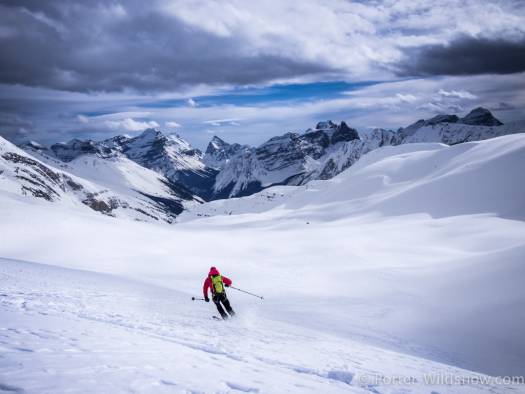
We didn’t do a ton of down skiing on this particular objective. But when we did, at least it was wind affected and/or sloppy.
WildSnow guest blogger Jed Porter is a full-time, year-round mountain guide currently on the road quite a bit. He wouldn’t say no to a turns-all-year schedule, but he sure enjoys the variety of mountain adventure that the guiding life provides. Check out his cool website.
Jed Porter is a passionate adventure skier and all-around mountain professional. His primary work is as a mountain guide, skiing and climbing all over the Americas and beyond. Learn more about him at his website linked below.


